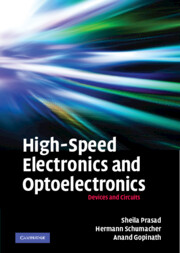1 - Review of semiconductor materials and physics
from Part One - Devices
Published online by Cambridge University Press: 05 August 2012
Summary
Executive summary
Semiconductor devices are fabricated using specific materials that offer the desired physical properties. There are three classes of solid state materials: insulators, semiconductors and conductors. This distinction is based on the electrical conductivity of these materials with insulators having the lowest and conductors having the highest conductivity. Semiconductors fall in between and their conductivity is affected by several factors such as temperature, the incidence of light, the application of a magnetic field and impurities. This versatility makes semiconductors very important in electronics and optoelectronics applications.
Semiconductors themselves are divided into two classes: elemental and compound. Each type has distinctive physical properties which are exploited in device design. Typical elemental semiconductor device materials are silicon and germanium; examples of compound semiconductors are GaAs, InP, AlGaAs and SiGe. The single crystal structure of these materials is that of a periodic lattice and this determines the properties of the semiconductors. Silicon has the diamond crystal structure and the compound semiconductors have the zincblende lattice structure. The bonding between atoms in a crystal of the semiconductors is termed covalent bonding, where electrons are shared between atoms. Fundamental principles of quantum mechanics are applied to determine the energy band structure of the semiconductor.
The basic device physics involves the description of the energy band structure, the density of states, the carrier concentration and the definition of donors and acceptors. Semiconductors are categorised as direct or indirect depending on the bandgap. The absorption mechanism is described and radiation and recombination processes important to device performance are detailed.
- Type
- Chapter
- Information
- High-Speed Electronics and OptoelectronicsDevices and Circuits, pp. 3 - 45Publisher: Cambridge University PressPrint publication year: 2009
- 1
- Cited by



